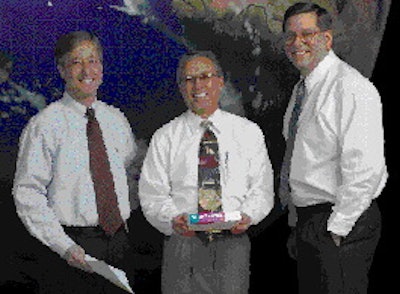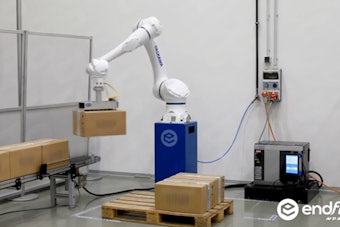Pharmaceutical giant SmithKline Beecham's prescription drug division is in the midst of an aggressive effort to redesign the way it handles packaging development for new products. The goal is to launch products sooner and in several countries at or near the same time, rather than sequentially, market-by-market. Avandia®, the Philadelphia-based firm's soon-to-be-launched diabetes drug, will be the first drug to be launched globally. "Since we started the whole program, this is the first true global launch that I've ever seen," says Angelo Scolieri, director, packaging and production technical services. "We're going to be launching in approximately 13 countries simultaneously." Aligning R&D with production The packaging department's contribution toward this global focus is to facilitate the "technology transfer" of new products between drug developers and the production and packaging plants. In the pharmaceutical industry, the Food & Drug Administration requires a series of stability tests to prove that the intended packaging material does indeed sufficiently protect the drug over time. Altogether, these tests cost hundreds of thousands of dollars and can last for years. Historically, a challenge has been identifying the optimum packaging components for these tests. While the drug is still under development, R&D must select packaging components with an imperfect knowledge of product stability requirements for pilot-scale testing. Typically, consultation with the packaging department did not occur until much later in the process, when large-scale pivotal qualifications tests were planned. However, testing of pilot batches continues for months and years, usually overlapping with production-scale testing. "You may go out with a product with an FDA approval for a shelf life of only two years," explains Scolieri. "Eventually you want to get to three years. So you continue testing," even after large-batch testing has begun. The problem is that if a packaging material fails one year into a stability test, that failure will show up first with the pilot-scale test. "If the initial component choice fails to provide adequate stability," says Scolieri, "and the package fails six months or a year into the test, we're starting from scratch again. That could cause us to lose a year from the development process." The second problem with the conventional approach is that R&D scientists had to choose packaging materials for pilot-batch testing months or years before the actual drug production facility was determined. "They'd tend to select a material used in one of our nearby plants," says Dennis O'Reilly. "But a regional material choice might not be appropriate if the product ends up being launched outside of their region." O'Reilly, the manager of package design, development and engineering, has played a key role in SB's global packaging initiative. Tom Pack, packaging design development project manager, elaborates: "We want to develop package testing data on commercially viable components, not on something that won't fit our packaging process. That way we won't have to go out and reinvest in new machines and new equipment or take what they've done and redo it in some way so it will work in the plant." Another complication: "Not unlike a lot of other companies, we grew in asymmetrical ways, through acquisitions, mergers and so forth," says O'Reilly. "So we have facilities that tend to use different materials." Choosing a single material for testing virtually precluded a global launch. That's because European plants tend to use blister packaging for all prescription drugs, while the U.S. favors bottles (blisters are common in the U.S. for physicians' samples). Testing a high-density polyethylene bottle for a drug meant that the drug wasn't being tested in a blister pack that would be necessary for a European launch. The bottom line: inadvertent delays. And in the pharmaceutical industry, where a drug patent represents an exclusive lock on a new product, such delays can be tremendously expensive in terms of lost revenue. "If you have a product that has potential sales of $365 million annually," Scolieri says, "every day you delay a drug launch, you lose a million dollars off the patent life." The patent is filed at the moment the chemical compound is discovered. So all package testing occurs "on the clock," while the patent life is ticking away. Indeed, this is part of a larger company effort to speed up all aspects of new product development for the prescription division, not just packaging. Explains Scolieri: "The goal is to have a well-aligned process that will assure that we'll be able to launch a new product from start to finish" in as little as five-and-a-half years. The industry standard is closer to 10 years. Packaging is expected to play an important, though not exclusive, role in that reduction. Packaging guidelines To eliminate delays and better prepare for global launches, SB's R&D and packaging departments now collaborate much earlier for initial package selection for pilot-scale testing. To facilitate choosing the right material, SB is in the midst of drawing up a series of packaging guidelines that consist of a list of core, standardized components. "The first thing we have to do is get agreement among plants to use common components," says O'Reilly. "The second thing is to get agreement with R&D to use the components the plants prefer." Pack elaborates: "The guidelines are something that R&D people will use to steer them in the correct direction so that commercial packaging components are used very early in the process, including clinical studies," says Pack. Facilitating global production While SB's European plants have experience with export markets, this is a new role for U.S.-based production facilities. "In the past, our U.S. plants had never really ever been in a situation where they've had to make product for markets outside North America," explains Pack. "Now we're being told we have to prepare these plants to make a product for 30, 50, 100 different countries around the world." A core set of components, chosen with all markets in mind, and to be used by all the plants, makes the task of packaging for those different markets much easier. Of course, by concentrating volume in a core set of components, SB expects it will obtain better pricing from its suppliers. However, the effort to standardize is not about lowering material cost, Scolieri emphasizes. "Those cost savings are minor compared to missing a launch date," which results in delays that eat into the remaining patent life. Consolidating materials SB's packaging department's first effort was to focus on solid oral-dose medication. That means blisters, used primarily overseas, and bottles, used mainly in the U.S. The packaging department has whittled its various components down to a core list of about 30 different components. The quantity is mostly due to the use of multiple bottle sizes and closure types, both regular and child-resistant. To assemble the list, SB first surveyed plants to find out what materials were used. As an example, O'Reilly notes that previously, R&D could select from 20 different grades of blister film being used across all of SB's plants. "We decided to just pick a few that we can all agree that we'll use no matter where we launch. We wound up selecting films that gave us the range of barrier requirements that typical products would likely need." What emerged were only three grades (see box): a low-, medium- and high-barrier spec in clear film and white opaque film. The latter is required in some countries for child-resistance. O'Reilly points out that these are specifications for sheet material, not vendors. Plants are still free to purchase from the same sources as before. From an R&D standpoint, all new products developed under this program will undergo stability testing in both blisters and bottles, simultaneously. "We're going to develop in both package formats knowing we're going to use both," O'Reilly says. Further, choosing from a short list of standard materials during R&D testing will allow SB to employ what O'Reilly calls a defensive packaging strategy. "With only three different blister films, we can fully evaluate two of them." That allows the company to hedge its bets in case one of the materials fails six months or a year into the test. "This kind of strategy isn't as easy to execute when you have 20 different materials," says O'Reilly. Standardizing on a core group of materials also yields benefits when it comes to machine validation in the production facilities. That's especially true in the event that the packaging of a given product needs to be switched from one plant to another. "We can essentially transfer the validation package to the new site," says Pack. The validation package refers to the set of protocols used to test the packaging of a product used on a specific machine with a given packaging material. "You'd still want to do [minor testing] at the new site because every piece of equipment is slightly different," concedes Pack. "But it would drastically reduce the effort needed to transfer packages from one plant to another." Challenges remain The effort is not without its challenges, admit Scolieri, O'Reilly and Pack. Currently, the core packaging specifications that make up the packaging guidelines exist as a paper document. Disseminating that document to SB personnel worldwide is difficult at best. Toward this end, Pack is spearheading the development of a system that will allow SB personnel to access the guidelines over the corporate intranet right from their desktop computers using a standard Web browser. That eliminates the need for special software installed on each desktop. The specs can be created and maintained centrally from Philadelphia, without the packaging department having to worry about disseminating those guidelines. The project is an outgrowth of an earlier project to computerize its packaging specs for North American operations (see Packaging World, Jan. '99, p. 32 and Feb '99, p. 60 or packworld.com/go/sb). Other departments, not just R&D, will also be able to access these standards, as well as the packaging specs used by North American plants. For example, overseas regulatory personnel use packaging specifications in the course of preparing filings to their FDA-equivalent governmental regulatory agencies. But like at most firms, development of this project is currently taking a back seat until the firm can resolve its Y2K issues. Pack hopes work can resume in earnest in the new system this summer, once resources now devoted to Y2K are freed up. Another potential problem with standardization of packaging components is the flip side of its supposed benefit. With fewer options available, R&D personnel might be forced to shoehorn a new drug into a high-barrier blister when it actually could be accommodated with a less-expensive material with characteristics in between SB's designated medium- and high-barrier standards. That has the potential to actually inflate packaging costs. "That's a legitimate issue, O'Reilly admits. "It can be addressed through post-approval change procedure if the economics are justified," he says. He adds that it's probably less of an issue in the prescription division. That's due to smaller volumes compared to its over-the-counter sibling, the consumer healthcare division, which has its own separate packaging and R&D departments and, to a large extent, separate production facilities. "When you consider the volumes associated with OTC products, that argument becomes more compelling," he allows. Another issue was persuading the plants. "It was a little difficult for plants that operated with 'out-of-standard' equipment," acknowledges Pack. He points to the standardization of induction-sealed liners for bottles. "Some of our facilities personnel objected, saying 'Wait, we don't have any induction-seal equipment.' In those cases, they needed to spend some money. To get everybody onto the same page, everybody had to sacrifice a little bit." A final limitation is that the benefits of standardization can only be reaped from new products, not existing ones. That's because once a prescription drug has been tested for commercial use in a given package, it's very expensive to change the package, because it requires new rounds of expensive, time-consuming stability tests. Worse, if the product is marketed in 50 different countries, the testing must be comprehensive enough to take into account the demands of potentially 50 different sets of national requirements for such tests. Although package standardization becomes limited to new products, over time, as old products become a smaller part of SB's portfolio, the strategy begins to take root, O'Reilly points out. "If we don't want to be talking about the same obstacles in 10 years' time, we've got to begin somewhere," he argues. "If we begin with the new products, then that's a lot easier than addressing all the barriers--and there are a lot--in changing the packaging for existing products." Getting a consensus One thing that wasn't an obstacle was gaining the support of the R&D groups. Scolieri and his crew started out by hitting the road, making presentations to more than 50 R&D managers worldwide. "We really didn't have any difficulty presenting this to R&D," claims O'Reilly, "because they were happy that we had aligned options as well as we had. It takes some doubt and risk out of their program." Even though the globalization effort began two years ago, only about a half dozen or so potential new products have been developed under the new process, without a single launch yet. Even the soon-to-be-launched drug Avandia, which was several years in the making, was developed the traditional way, although it's now in a position to be launched globally. All three packaging specialists admit it's too soon to tell whether the effort is actually saving time, given the length of time a new drug takes to develop, even under the new system. "Except that it makes sense," counters O'Reilly. "Why take a risk if you don't have to? As long as R&D is using materials to give them adequate product protection, they don't care if they use this or that--they're generally happy to use what the plant wants to use. "Instead of R&D developing it within their walls and then throwing it over the wall to production, we're now working alongside each other," says O'Reilly. "We're basically trying to reduce barriers." Concludes Pack: "It's also about maximizing assets. Because of the standardization, there's not as much complexity. So you can get approval quicker and roll that product into more markets as quickly and efficiently as you can."
























